When people think of sustainable designs they often focus on the outside, concerning themselves with making the structures of buildings sustainable. However, there are many components that can be installed inside a building to increase its sustainability. One fine example is the light tube or light pipe. Light tubes are used for transporting or distributing daylight. As a result they are often called tubular daylighting devices, sun pipes, sun scopes, or daylight pipes. No matter what you call it, the light tube is an excellent way to increase the sustainability of interior designs.
Light tubes take advantage of natural light thereby decreasing the need for artificial light. Natural lighting is an important tool in attaining sustainability. The generation of electricity is one of the largest contributors of pollution in the United States, which produces harmful chemicals such as sulfur dioxide, carbon, and mercury emissions. Production of electric power can also be linked with other environmental issues such as the impact on water quality, increased production wastes, and increased industrial zones. Therefore, reduction in the use of artificial lighting is vital for increasing sustainability.
Light tubes can be used in both the residential and commercial setting effortlessly with many advantages. Light tubes provide exceptional lighting. In fact the light output is incredible, providing as much light as you would expect from a skylight many times its size. It is also cost-effective. Light tubes cost considerably less than other daylighting options, such as windows and skylights, including both product and installation costs. It can also be installed with ease. They require no structural reframing, tunneling, drywalling or painting. Light tubes can also go about anywhere. The compact and flexible design allows them to be installed in just about any room, including rooms without direct roof access and smaller spaces where daylighting would usually not be an option. Light tubes are also “green.” Light tubes allow you to switch off electric lights during the day, which provides savings on energy bills and also as stated before reduces environmental pollution. Light tubes are beneficial to your health. It has been show in several prominent studies that increasing daily exposure to natural light can enhance mental and physical well-being, boost concentration and energy levels. It is apparent that Light tubes are extremely advantageous along with being environmentally friendly.
The Light tube is essentially a tube lined with highly reflective material that leads the light rays through a building starting from an entrance-point located on its roof or on the outer wall. The entrance point usually comprises a dome, which has the function of collecting and reflecting as much sunlight as possible into the tube. Many units also take advantage of directional “collectors,” “reflectors” or even Fresnel lens devices that assist in collecting additional directional light down the tube. Light transmission efficiency is greatest if the tube is short and straight. In longer, angled, or flexible tubes, part of the light intensity is lost. To minimize losses, a high reflectivity of the tube lining is crucial. At the end point, a diffuser spreads the light into the room. To further optimize the use of solar light, a heliostat can be installed which tracks the movement of the sun, thereby directing sunlight into the light tube at all times of the day as far as the surroundings’ limitation allow, possible with additional mirrors or other reflective elements that influence the light path. The heliostat can be set to also capture moonlight at night.
The design of the Light tube makes it a great sustainable design. The Light tube’s ability to transfer daylight into areas that normally would experience none, helps cut down on the use of artificial lighting. The decrease in artificial lighting, in turn, minimizes pollution. Overall, the Light tube is a superior way to include sustainability into interior designs.








